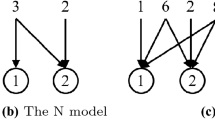Abstract
We explore settings where it is necessary (due to physical or operational constraints) or desirable (due to synergies or ease of implementation) to assign resources to tasks in a synchronous manner. We model the system as a queueing network with flexible servers and introduce the notion of a configuration to address the synchronous assignment of servers. This allows for a unified approach to determine the effects of resource synchronization, covering a wide range of problems in the literature. The maximal capacity of the system is given by the solution of a linear programming problem that also provides the optimal fractions of time the servers should spend in different configurations. This is used as a basis for constructing policies that have capacity arbitrarily close to the maximal capacity. We contrast synchronous server assignment with an asynchronous approach (focusing on independently scheduling individual servers rather than configurations) and show that synchronous server assignment is attractive with respect to applicability (it can capture constraints on server assignment and synergies among servers), implementation (it may have significantly fewer combinations of server allocations), and capacity (when both are applicable, asynchronous and synchronous server assignment will yield the same maximal capacity). Finally, we illustrate our modeling framework using several examples.
Similar content being viewed by others
References
Ahn HS, Duenyas I, Zhang RQ (2004) Optimal control of a flexible server. Adv Appl Probab 36:139–170
Ahn HS, Lewis ME (2013) Flexible server allocation and customer routing policies for two parallel queues when service rates are not additive. Oper Res 61:344–358
Andradóttir S, Ayhan H, Down DG (2003) Dynamic server allocation for queueing networks with flexible servers. Oper Res 51:952–968
Andradóttir S, Ayhan H, Down DG (2007) Compensating for failures with flexible servers. Oper Res 55:753–768
Andradóttir S, Ayhan H, Down DG (2011) Queueing systems with synergistic servers. Oper Res 59:772–780
Andradóttir S, Ayhan H, Down DG (2013) Optimal assignment of servers to tasks when collaboration is inefficient. Queue Syst 75:79–110
Briggs KC, Myers IB (1976) Myers–Briggs type indicator: form F. Consulting Psychologists Press, Palo Alto
Comrey AL (1983) An evaluation of the Myers–Briggs type indicator. Acad Psychol Bull 5:115–129
Dai JG (1995) On positive Harris recurrence of multiclass queueing networks: a unified approach via fluid limit models. Ann Appl Probab 5:49–77
Dai JG (1999) Stability of fluid and atochastic processing networks, Publication 9, Centre for Mathematical Physics and Stochastics. www.mathphysto.dk
Dai JG, Lin W (2005) Maximum pressure policies in stochastic processing networks. Oper Res 53:197–218
Down DG, Karakostas G (2008) Maximizing throughput in queueing networks with limited flexibility. Eur J Oper Res 187:98–112
Faaland BH, Klastorin TD, Schmitt TG (1992) Assembly line balancing with resource dependent task times. Decis Sci 23:343–364
Gurumurthi S, Benjaafar S (2004) Modeling and analysis of flexible queueing systems. Naval Res Log 51:755–782
Gurvich I, Van Mieghem JA (2015) Collaboration and multitasking in networks. Manuf Service Oper Manag 17:16–33
Gurvich I, Whitt W (2009) Scheduling flexible servers with convex delay costs in many-server service systems. Manuf Service Oper Manag 11:237–253
Işık T, Andradóttir S, Ayhan H (2016) Optimal control of queueing systems with non-collaborating servers. Que Syst 84:79–110
Jiang L, Walrand J (2010) Scheduling and congestion control for wireless and processing networks. Synth Lectur Commun Networks 3:1–156
Jordan WC, Graves SC (1995) Principles on the benefits of manufacturing process flexibility. Manag Sci 41:577–594
Kara Y, Özgüven C, Yalçın N, Atasagun Y (2011) Balancing straight and U-shaped assembly lines with resource dependent task times. Int J Prod Res 21:6387–6405
Mandelbaum A, Stolyar AL (2004) Scheduling flexible servers with convex delay costs: heavy-traffic optimality of the generalized \(c\mu\) rule. Oper Res 52:836–855
Mas A, Moretti E (2009) Peers at work. Am Econ Rev 99:112–145
McCrae RR, Costa PT (1989) Reinterpreting the Myers–Briggs type indicator from the perspective of the five-factor model of personality. J Personal 57:17–40
Moore T (1987) Personality tests are back. Fortune 30:74–82
Peltokorpi J, Tokola H, Niemi E (2015) Worker coordination policies in parallel station systems: performance models for a set of jobs and for continuous arrival of jobs. Int J Prod Res 53:1625–1641
Schultz KL, Schoenherr T, Nembhard D (2010) An example and a proposal concerning the correlation of worker processing times in parallel tasks. Manag Sci 56:176–191
Shunko M, Niederhoff J, Rosokha Y (2018) Humans are not machines: the behavioral impact of queueing design on service time. Manag Sci 64:453–473
Tassiulas L, Ephremides A (1992) Stability properties of constrained queueing systems and scheduling policies for maximum throughput in Multihop radio networks. IEEE Trans Autom Control 37:1936–1948
Wang X, Andradóttir S, Ayhan H (2015) Dynamic server assignment with task-dependent synergy. IEEE Trans Autom Control 60:570–575
Acknowledgements
We would like to thank the anonymous referees for their useful comments. The research of the first two authors has been supported by NSF under grant CMMI-1536990. The third author has been supported by NSERC under the Discovery Grant program.
Author information
Authors and Affiliations
Corresponding author
Additional information
Publisher's Note
Springer Nature remains neutral with regard to jurisdictional claims in published maps and institutional affiliations.
Rights and permissions
About this article
Cite this article
Andradóttir, S., Ayhan, H. & Down, D.G. Synchronous resource allocation: modeling, capacity, and optimization. OR Spectrum 44, 1287–1310 (2022). https://doi.org/10.1007/s00291-022-00684-x
Received:
Accepted:
Published:
Issue Date:
DOI: https://doi.org/10.1007/s00291-022-00684-x




